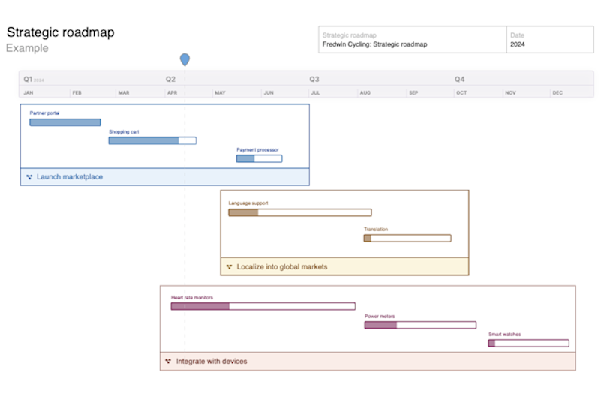What product strategy is not:
Vision and mission: The company (or product) vision and mission are foundational components of a strategy
Metrics: KPIs give a sense of how you are tracking against product goals, which in turn are a component of your product strategy
Budget: Financial resources enable (or constrain) your ability to deliver against the product strategy
Ideas: Creative concepts and requests for enhancements can support innovation if they align with the product strategy
Features: Individual features (or even a collection of functionality) are one way that you might achieve the product strategy
Roadmaps: Roadmaps visualize the product strategy and offer a timeline for implementation and delivery
Launch plans: A list of activities that a cross-functional team will complete as part of releasing new functionality to market
People fall into the trap of thinking that the plan for how they will build something new is itself a product strategy. This is especially common in early-stage companies or on teams lacking in strong product leadership. Product plans are certainly critical to product development. Vision, goals, ideas, and tactics are necessary too — but none are actually a product strategy.
Related: Why strategic thinking is so hard for product managers
Top
What goes into a product strategy?
Executives and product leaders typically collaborate to define the product vision and determine how your product will serve a specific customer segment. The exploration phase of setting a product strategy often involves competitive analysis, vetting different business models, and creating product positioning. This needs to happen before any detailed product roadmap work begins. (For a more in-depth look at what happens in each stage of product development, check out our approach in this guide to the activities in The Aha! Framework).
The team at Aha! are all product development experts. Collectively we have hundreds of years experience planning, building, and launching new offerings. We put all of that knowledge into our own software suite. Those learnings informed how we structure product strategy in Aha! Roadmaps.
Our major areas of focus for product strategy are organized into three categories — foundation, market, and imperatives. The sections below reveal the mindset that a product manager should be in when developing a product strategy, along with best practices, tools, and tactics you can use during the process.
Foundation: What you want to achieve
You seek to understand the market context you operate in, are able to define why your offering is superior, and can identify growth opportunities.
Vision: Represents the core essence of your product and what makes it unique. It should be something that everyone in the company deeply understands — the "why" behind the product you are all responsible for.
Business models: Models are useful when you launch a new product or want to evolve your strategy as the market changes. There are many types of business models — including lean canvas, Porter's 5 forces, and the 10Ps marketing matrix.
Positioning: Define where your product fits in the marketplace and the unique benefits you provide. Strong positioning supports your marketing strategy, brand storytelling, and all content developed for customers.
Market: Who you will serve
You are curious about who your customers are, can empathize with the problems they have, and are familiar with any alternatives to your offering.
Personas: Fictional characters bring your customers to life. Creating user personas is one way to develop empathy for your customers — you document their likes and dislikes, professional aspirations, challenges, and more.
Competitive analysis: Understand where your offering excels and falls short compared to other solutions in the marketplace. Doing this type of research provides insights into where you fit within the broader market and what opportunities might prove most valuable for your customers and the business.
Imperatives: What you will accomplish
You set time-bound and specific goals and identify initiatives that will help you achieve your strategy.
A note about goals
Defining goals and initiatives is typically done towards the end of setting product strategy. With all of the information that you have gathered and reviewed during that process, it can be tempting to choose many goals and many initiatives. You want to make everyone happy, right?
A product that serves everyone actually serves no one. Too many strategic imperatives will confuse the team and lead to muddy decision-making. So you want to be shrewd when selecting goals and initiatives — fewer, specific objectives will make it easier to select features that will make a real impact. If you use Aha! software, this record map template can help you visualize how these strategy pieces fit together.
Top





